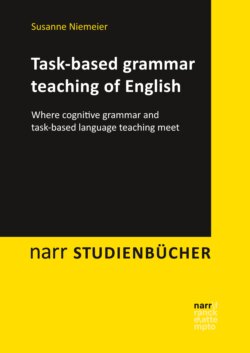Читать книгу Task-based grammar teaching of English - Susanne Niemeier - Страница 9
На сайте Литреса книга снята с продажи.
1.1 Current situation
ОглавлениеIn most German foreign language classrooms, the so-called PPP (presentation – practice – production) approach is currently chosen when it comes to grammar teaching. In this approach, a new grammatical feature is first presented to the learners, normally via the coursebook, which usually contains one or more didacticised texts with an inauthentically high number of occurrences of the phenomenon in question. In a second step, the teacher then explains this phenomenon deductively or lets the learners discover it inductively. This is followed by an analysis of the form and use of the new structure, and finally rules (and sometimes signal words) are formulated, which have to be written down by the learners and learnt by heart. The third step focuses on the learners’ controlled production and use of the targeted phenomenon, frequently in exercises consisting of isolated sentences. However, the meaningfulness of the new grammatical structure is hardly ever touched upon and the PPP procedure does not necessarily enable the learners to use the grammatical phenomenon in naturally occurring conversation outside of the classroom.
R. ELLIS (2003: 29) mentions that “implicit in PPP is the idea that it is possible to lead learners from controlled to automatic use of new language features”. However, such use would normally still be decontextualised, i.e., it is not pragmatically anchored in a specific usage context. R. ELLIS continues his convincing arguments against the PPP approach by criticising that “PPP views language as a series of ‘products’ that can be acquired sequentially as ‘accumulated entities” (ibid.), that “SLA research has shown that learners do not acquire a language in this way” (ibid.) and that “L2 acquisition is a ‘process’ that is incompatible with teaching seen as the presentation and practice of a series of ‘products’” (ibid.). Furthermore, PPP is a very teacher-centred approach and the learners normally only react to the teacher’s and/or the coursebook input, but do not become the pro-active and collaborative learners which they are meant to be from a more modern perspective, which is also the perspective of task-based language teaching.
Grammar is an omnipresent phenomenon in the foreign language classroom and it is generally not liked too much, neither by the learners nor by the teachers. Learning to master a foreign language certainly involves learning (about) the grammar of this language as well, however, there are many different opinions on what ‘grammar’ actually is. Most people would probably say that the term relates to the structural aspects of language and they would contrast it with the notion of ‘vocabulary’. Indeed, when it comes to the competences to be acquired in foreign language teaching, most current EFL textbooks still differentiate between ‘vocabulary’ and ‘grammar’ / ‘structures’ in their tables of contents. Cognitive grammar, on the other hand, argues that lexis and grammar are inseparably intertwined and form two ends of a continuum, sharing many organisational principles (such as categorisation, (un)boundedness and metaphorization, among others) – this is explained in more detail in the third chapter.
Language cannot be defined without these two poles of the continuum. If there was only vocabulary, people would run around and utter single words – and this is certainly not what is meant by “communication”. If there was only grammar and no words, nothing could be said or even thought at all. Both ingredients are necessary and work together. Even a very simple sentence like “Mary runs” does not only contain words, but is full of grammar as well. On the one hand, the sentence follows the English word order in that the subject is placed before the verb. As the verb is intransitive in its motion meaning1, it cannot have an object. Furthermore, the sentence is tensed (third person singular present tense) and the non-use of the progressive aspect states that the sentence does not describe an ongoing activity but instead a habitual one, as Mary may be a member of a running team with regular running meetings, or that Mary always runs when under stress, for example. What is still more, the sentence talks about reality, as otherwise modal auxiliaries would be used (Mary could run, Mary may run, Mary ought to run etc. – all of them indicating various extents of distance towards reality and all of them indicating that it is not a proven fact that Mary runs).
Therefore, even in the very first English lessons for beginning learners, in which simple sentences such as the one mentioned above are used on a regular basis, grammar is an ever-present asset and contributes a lot to the meanings of the utterances made, although in a more abstract way than vocabulary does. This is why grammar should never be neglected in the foreign language classroom and why learners need to be made aware of the meaning components that grammar contributes to the overall meaning of an utterance. Although WIDDOWSON (1990: 97) correctly argued already thirty years ago that “language learning is essentially learning how grammar functions in the achievement of meaning”, this sound piece of advice has hardly been accepted and grammar has rather been taught “for grammar’s sake”.
